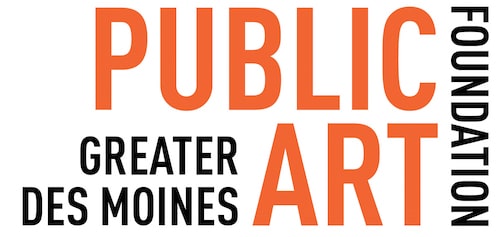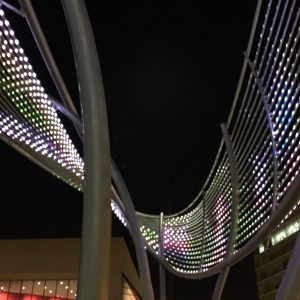
Greater Des Moines Public Art Foundation
Educational and Family Resource
Swirl
ABOUT SWIRL AND THE ARTIST
The idea of having an electronic installation in Cowles Commons came about several years ago, in 2008, during the planning of Nollen Plaza’s transformation into what would become Cowles Commons. Artist Jim Campbell was involved from the start on a design team with Des Moines-area landscape architect Ken Smith. Campbell knew he wanted to incorporate electronic media and have the space be interactive: plenty of seating to encourage togetherness, water spouts with their own lighting for playfulness – even the Crusoe Umbrella settled here! Finally in 2015, the $1.5 million Swirl began its permanent installation over several weeks in the large, open design of Cowles Commons. As dusk arrives and the sky ventures into darkness, Swirl becomes an “illuminated nightscape” of more than 8,000 LEDs dashing around 18 loops wound around nine 30-foot long poles.
Prior to his joining the design team for the Commons, Jim Campbell’s name was brought up by Des Moines Art Center Director Jeff Fleming, who was familiar with the San Francisco-based artist after curating his work over 20 years ago at the Southeastern Center for Contemporary Art in Winston-Salem, N.C. Jim Campbell started his electrifying artwork back in the 1980s with video art. In the ‘90s, he transitioned into “electronic sculpture and then LED matrix works that examined the nature of motion and optics.” Campbell has installations nationally and internationally, including a past LED showing on a 108-story Hong Kong skyscraper.
-Adapted from: Morain, M. (2015, December 21). Light art flickers to life downtown. Des Moines Register.
VOCABULARY
- LED: light-emitting diode: a semiconductor diode that produces light approximately 90% more efficiently than incandescent bulbs.
- Diode: a device, like a semiconductor, that controls the direction of current-flow towards one direction.
- Installation art: large three-dimensional artwork, sometimes mixed-media, which is constructed in the space where it is exhibited. Can be site-specific and designed to transform or have a relationship with its space.
Discussion Questions
- What are your first thoughts when seeing this work? Do any initial words or phrases come to mind?
- Why do you think Swirl was placed in the middle of Cowles Commons?
- What images can you find swirling around? (Tell students clouds, blue sky, and recorded feet from the 2015 Des Moines Marathon are illuminated). Why might the artist have chosen to use the moving images of feet from a previous Des Moines Marathon for this artwork?
- What do you notice about the image – is it crisp, abstract, etc.? If you are nearer to Swirl, can you see the moving image better, or does it change depending on your distance ratio?
- This artwork was commissioned by the Des Moines Performing Arts and sits across from the Civic Center. How might Swirl help represent DMPA?
Literature
- Emily Coker and Kelli Townley. Make It Glow: LED Projects for the Whole Family. San Francisco: Maker Media, 2016. (All ages)
The entire family can enjoy making 21 LED projects through an exploration of electronics and soft circuits. Find step-by-step instructions and full-color photos throughout the book to help you make projects like jewelry and home decor.
- Maggie Murphy. High-Tech DIY Projects with Electronics, Sensors, and LEDs (Maker Kids). PowerKids Press, 2014. (grades 5-8)
The maker movement is an “online community among adult and teenage builders of technology devices.” This particular book provides plenty of patterns and instructions for step-by-step electronics, sensors, and LED projects.
- John R. Matthews. Inventions That Shaped the World: The Light Bulb. Scholastic, 2005. (grades 4-7)
This short book journeys through the various light sources used before the invention of the incandescent light bulb.
- Scott Welvaert. Thomas Edison and the Lightbulb (Inventions and Discovery). Capstone Press, 2006. (grades 4-8)
This graphic novel approach to nonfiction will catch the attention of students who may enjoy reading nontraditional literature. Extras in this book include a Glossary, a Read More section, an Index, a Bibliography, and a catalog of related Internet Sites.
Internet Resources
The artist’s own website documents all past and present installations, public arts, and commissions, along with his own publications and an updated newsfeed.
This short article presents Light Festivals around the world with a brief description and official websites for each festival. Consider catching a flight to Amsterdam or keeping things more “local-ish” by heading to Baltimore! While on this website, have a look around at the other News & Stories, along with past and current projects this LED Company has completed.
- Complete Lesson Plan: This Little Light of Mine: Understanding Light Bulbs (Tracy Empson for earthdaynetwork.com)
This lesson plan addresses National Standards and is designed for one class period in grades 5-8 introducing “students to the basic mechanics of how light bulbs work. Students will explore the different types of light bulbs available and the relationship between light, electricity, and heat. Finally, they will build their own flashlights and reflect on this process.” Lesson plan includes activities, articles with Guided Reading Questions, and guiding worksheets.
- Article: Jim Campbell’s Sculptural LED Light Installations, The Creators Project. 19 May, 2014.
(5-12) This short Vice profile of Campbell accompanies the video below, with beautiful photos of his 2014 retrospective show, Rhythms of Perception, premiering as his “first major exhibition in a New York museum” (Museum of the Moving Image).
- (YouTube video embedded in article) Jim Campbell’s Scultural LED Light Installations (2014; 4 minutes 35 seconds)
(3-12) Watch this fascinating behind-the-scenes video and interview with Jim Campbell as he takes the viewer through a 2014 series of light installations at Bryce Wolkowitz Gallery (NYC). “The exhibition ranges from LED panels that project ultra low-resolution Kodachrome home movies, to topographic LED sculptures created from transparent, molded resin.”
- Additional History Videos:
- YouTube: Invention of BULB|The Dr. Binocs Show|Best Learning Video for Kids| Preschool Learning (2017; 5 minutes 24 seconds)
Preschool-lower Elementary teachers can use this video in a full-class activity: task students with taking on 1-2 major events and creating illustrations hung from wire, attached to large paper-printed dates.
- YouTube: Let There Be Light- The Invention of the Light Bulb|THE INDUSTRIAL REVOLUTION (2015; 7 minutes 50 seconds)
(8-12) A comedic look at the history of the light bulb invention.
Art Activities
PRE-/POST-VISIT ACTIVITIES
Make sure to review the vocabulary terms, above, to familiarize students with necessary terms.
- Get Familiar with History
(Social Studies, 5-12)
The history of the lightbulb is a fascinating journey, more complicated than the average person knows. Deepen students’ appreciation of Swirl by delving into the origins of the lightbulb with a 44-minute National Geographic American Genius Series documentary: Edison vs. Tesla:
- Full documentary on YouTube
- National Geographic program webpage: contains photos and digital extras
Encourage students to take notes of important dates and events for use in the following Timeline activity. A shorter history video for upper middle/high school students and a much lower-level video for preschool/lower elementary can be found in the Internet Resources.
- Create a Timeline
(5-12, ELA, Social Sciences, Technology, Art)
Using notes from the documentary as well as the timelines links below, older students can create a physical or digital timeline with images to represent the major events in the history of electricity. Physical timelines should include illustrations; digital timelines can include videos, photos, and articles involving key figures and events of each decade. Preschool/lower-elementary can find an adapted version of this activity with the short video in the Internet Resources.
- History of the Light Bulb (softschools.com): provides a succinct interactive timeline with explanation of events; useful for grades 5-7.
- The History of the Light Bulb (US Dept. of Energy): Thorough and informative timeline of the history of the light bulb, including an interactive timeline you can manipulate with your mouse. Very in-depth but more rigorous reading level; useful for grades 8-12.
- Electricity in Your Classroom
(Pre-K – High School, Science, Technology, Art)
The following activities are separated by grade-range, varying in objective and required materials (all materials and instructions are included on the following links):
- Preschool/Lower-Elementary: Maker Space Activities Using LEDs (W. Ian O’Byrne)
The blogger had his 3 ½ year old son help him present this project during a 2014 Print2Pixel Unconference. Modifications for the preschool level are included on this link.
- Elementary: Electric Play Dough (PBSParents)
PBS presents a fun play-dough experiment that would excite the elementary-age child, developed by AnnMarie Thomas of the St. Thomas Lab at the University of St. Thomas. A video overview of the project plus instructions to make the two special play doughs are linked within, along with additional fun science experiments.
- Middle/Secondary: Circuits & LED Projects (Maker Education)
A large number of projects are linked on this page, from paper circuits to a mini bug robot! Several videos are included as well as an embedded Circuit Sticker Sketchbook. Consider using one of the activities in your classroom, and encourage students to try additional projects at home. While you are on the website, explore the many additional types of STEM activities provided, including robotics and coding.
- All ages: Paper Circuits (The Tinkering Studio|Exploratorium)
Incorporate art-making with surface-mounted LEDs to light up students’ paper designs. This activity has many encouraging ideas, like a light-up greeting card or a 3D pop-up paper sculpture. Downloadable Paper Circuits activity guide included.
STAMP YOUR LOCAL CULTURAL PASSPORT
- The High Trestle Trail Bridge is a beautiful LED installation commissioned by the Greater Des Moines Public Art Foundation in April 2011. The award-winning work spans 13.5 feet across the Des Moines River between Madrid and Woodward, standing 13 stories high and emitting electric blue LED lights.
STAMP YOUR NATIONAL CULTURAL PASSPORT
- San Francisco, CA has an enormous variety of LED installations, temporary and permanent, commissioned by or in partnership with the nonprofit arts organization Illuminate. At com, you will find photos and videos of these installations in the Installation Gallery, along with information about the artists, the artwork itself, directions to the artwork, and dates for temporary installations. The thorough website even includes guided tours and self-guided itineraries for your personal planning. San Francisco truly seems to represent “Bright lights in the big city!”
- The Seattle Art Museum has a giant LED and glass art installation display called Mirror, by artist Doug Aitken, commissioned by philanthropist Bagley Wright in 2011 and unveiled in 2013. The outdoor display incorporates changing light columns and moving images to represent local life, spanning 12 stories and two facades of the museum itself (photo at left).

